一般疑问句句型转换
- 格式:xls
- 大小:18.00 KB
- 文档页数:1
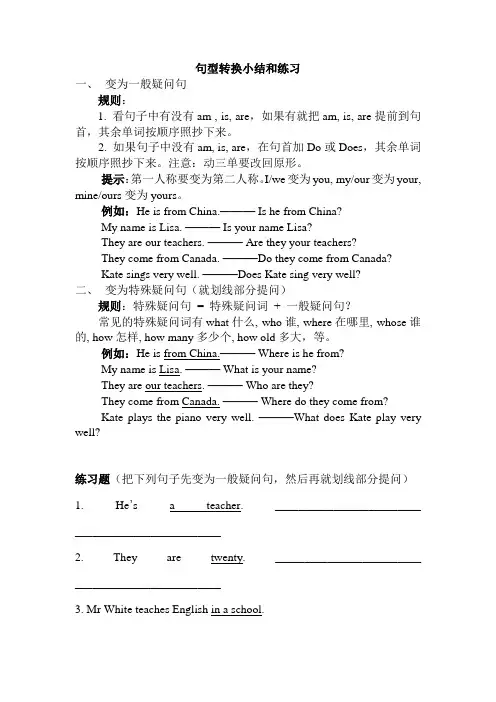
句型转换小结和练习一、变为一般疑问句规则:1. 看句子中有没有am , is, are,如果有就把am, is, are提前到句首,其余单词按顺序照抄下来。
2. 如果句子中没有am, is, are,在句首加Do或Does,其余单词按顺序照抄下来。
注意:动三单要改回原形。
提示:第一人称要变为第二人称。
I/we变为you, my/our变为your, mine/ours变为yours。
例如:He is from China.——— Is he from China?My name is Lisa. ——— Is your name Lisa?They are our teachers. ——— Are they your teachers?They come from Canada. ———Do they come from Canada?Kate sings very well. ———Does Kate sing very well?二、变为特殊疑问句(就划线部分提问)规则:特殊疑问句= 特殊疑问词+ 一般疑问句?常见的特殊疑问词有what什么, who谁, where在哪里, whose谁的, how怎样, how many多少个, how old多大,等。
例如:He is from China.——— Where is he from?My name is Lisa. ——— What is your name?They are our teachers. ——— Who are they?They come from Canada. ——— Where do they come from?Kate plays the piano very well. ———What does Kate play very well?练习题(把下列句子先变为一般疑问句,然后再就划线部分提问)1. He’s a teacher. _________________________ _________________________2. They are twenty. _________________________ _________________________3. Mr White teaches English in a school.__________________________________________________________________________________4. I come from Australia._______________________ _______________________5. His mother is a nurse. _______________________ _______________________6. They work in Beijing Hospital.__________________________________________________________________________________。
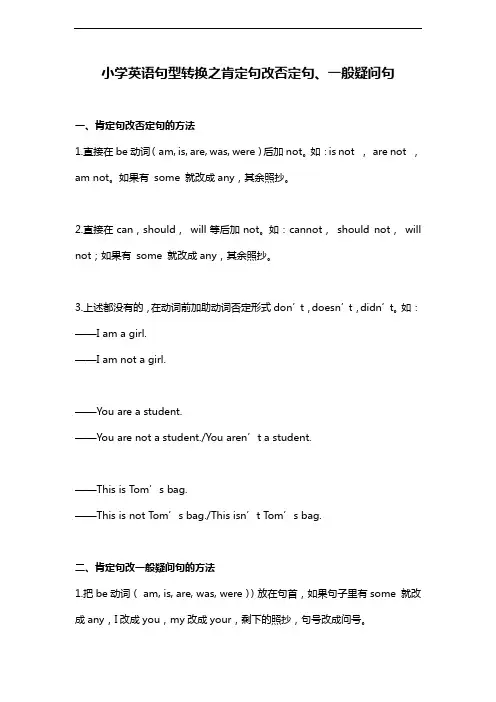
小学英语句型转换之肯定句改否定句、一般疑问句一、肯定句改否定句的方法1.直接在be动词(am, is, are, was, were)后加not。
如:is not ,are not ,am not。
如果有some 就改成any,其余照抄。
2.直接在can,should,will等后加not。
如:cannot,should not,will not;如果有some 就改成any,其余照抄。
3.上述都没有的,在动词前加助动词否定形式don’t,doesn’t,didn’t。
如:——I am a girl.——I am not a girl.——You are a student.——You are not a student./You aren’t a student.——This is Tom’s bag.——This is not Tom’s bag./This isn’t T om’s bag.二、肯定句改一般疑问句的方法1.把be动词( am, is, are, was, were))放在句首,如果句子里有some 就改成any,I改成you,my改成your,剩下的照抄,句号改成问号。
2.把can,shall,will,would,should ,could,may ,must等放到句首,如果句子里有some 就改成any,I就改成you,my就改成your,剩下的照抄,句号改成问号。
3.上述都没有的,就在句首加助动词Do,Does,Did帮忙,如果句子里有some 就改成any,I就改成you,my就改成your,剩下的照抄,句号改成问号。
4.注意:句首的第一个字母要大写,句尾标点应为“?”。
变一般疑问句时,肯定句是I am …,就把I am …变成Are you …?变一般疑问句时,肯定句I was …,就把I was …变成Were you …?如:——I am in Class 6.——Are you in Class 6?——You are from America.——Are you from America?——It is an orange.——Is it an orange?5.就一般疑问句回答一般疑问句有两种回答,即:肯定回答和否定回答。
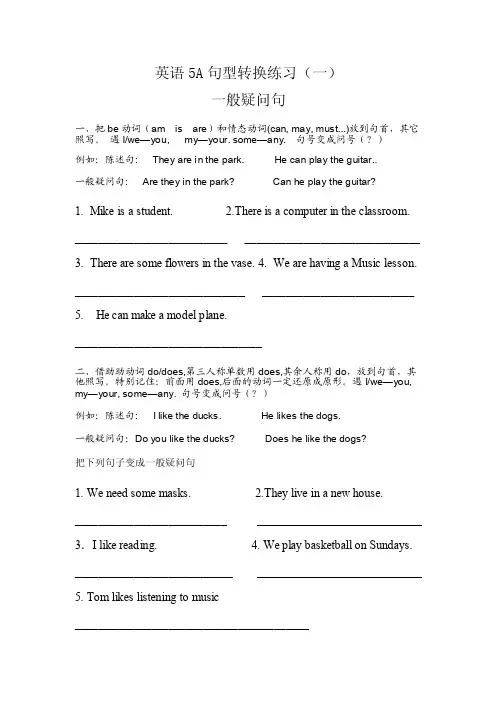
英语5A句型转换练习(一)一般疑问句一、把be动词(am is are)和情态动词(can, may, must...)放到句首,其它照写。
遇I/we—you, my—your. some—any. 句号变成问号(?)例如:陈述句: They are in the park. He can play the guitar..一般疑问句: Are they in the park? Can he play the guitar?1. Mike is a student.2.There is a computer in the classroom. __________________________ ______________________________3. There are some flowers in the vase.4. We are having a Music lesson. _____________________________ __________________________5. He can make a model plane.________________________________二、借助助动词do/does,第三人称单数用does,其余人称用do,放到句首,其他照写。
特别记住:前面用does,后面的动词一定还原成原形。
遇I/we—you, my—your, some—any. 句号变成问号(?)例如:陈述句: I like the ducks. He likes the dogs.一般疑问句:Do you like the ducks? Does he like the dogs?把下列句子变成一般疑问句1. We need some masks.2.They live in a new house.__________________________3.I like reading. 4. We play basketball on Sundays. ___________________________5. Tom likes listening to music________________________________________。
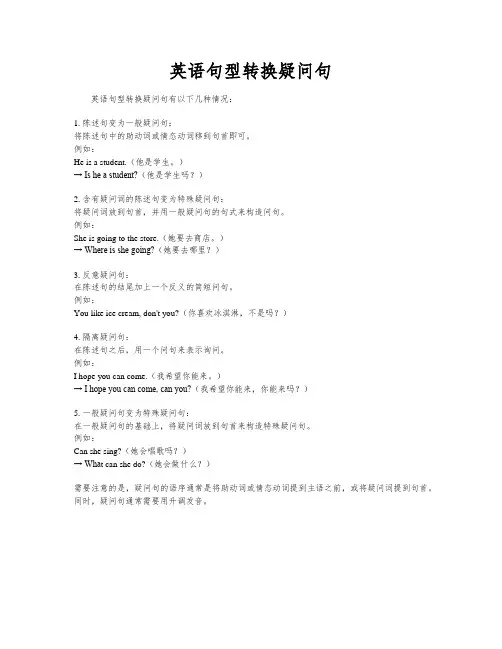
英语句型转换疑问句
英语句型转换疑问句有以下几种情况:
1. 陈述句变为一般疑问句:
将陈述句中的助动词或情态动词移到句首即可。
例如:
He is a student.(他是学生。
)
→ Is he a student?(他是学生吗?)
2. 含有疑问词的陈述句变为特殊疑问句:
将疑问词放到句首,并用一般疑问句的句式来构造问句。
例如:
She is going to the store.(她要去商店。
)
→ Where is she going?(她要去哪里?)
3. 反意疑问句:
在陈述句的结尾加上一个反义的简短问句。
例如:
You like ice cream, don't you?(你喜欢冰淇淋,不是吗?)
4. 隔离疑问句:
在陈述句之后,用一个问句来表示询问。
例如:
I hope you can come.(我希望你能来。
)
→ I hope you can come, can you?(我希望你能来,你能来吗?)
5. 一般疑问句变为特殊疑问句:
在一般疑问句的基础上,将疑问词放到句首来构造特殊疑问句。
例如:
Can she sing?(她会唱歌吗?)
→ Wha t can she do?(她会做什么?)
需要注意的是,疑问句的语序通常是将助动词或情态动词提到主语之前,或将疑问词提到句首。
同时,疑问句通常需要用升调发音。
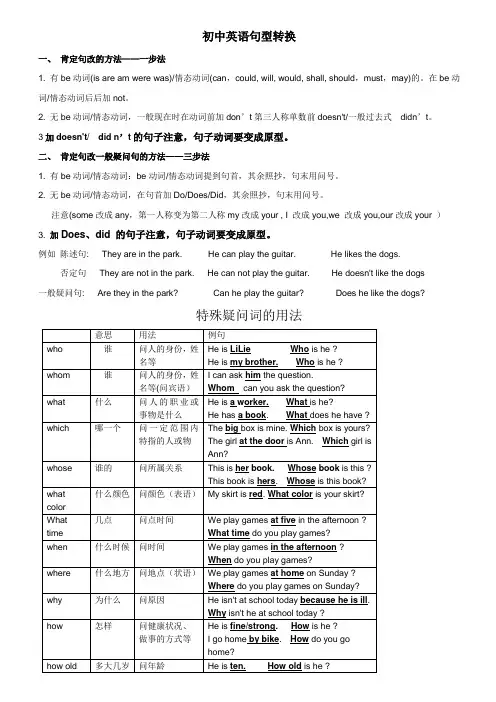
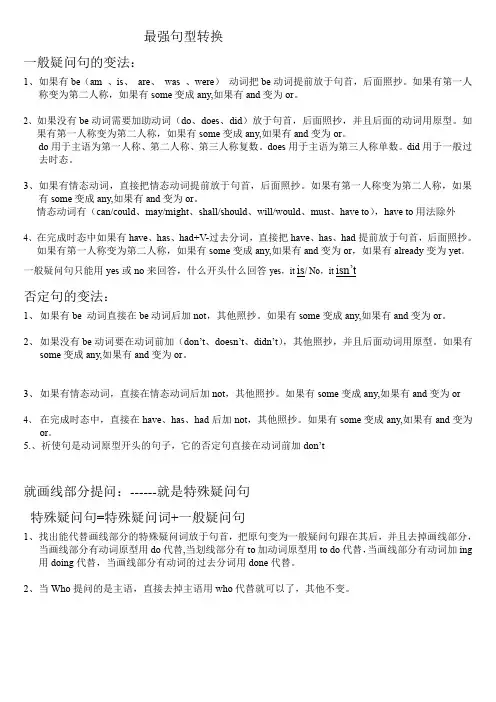
最强句型转换一般疑问句的变法:1、如果有be(am 、is、are、was 、were)动词把be动词提前放于句首,后面照抄。
如果有第一人称变为第二人称,如果有some变成any,如果有and变为or。
2、如果没有be动词需要加助动词(do、does、did)放于句首,后面照抄,并且后面的动词用原型。
如果有第一人称变为第二人称,如果有some变成any,如果有and变为or。
do用于主语为第一人称、第二人称、第三人称复数。
does用于主语为第三人称单数。
did用于一般过去时态。
3、如果有情态动词,直接把情态动词提前放于句首,后面照抄。
如果有第一人称变为第二人称,如果有some变成any,如果有and变为or。
情态动词有(can/could、may/might、shall/should、will/would、must、have to),have to用法除外4、在完成时态中如果有have、has、had+V-过去分词,直接把have、has、had提前放于句首,后面照抄。
如果有第一人称变为第二人称,如果有some变成any,如果有and变为or,如果有already变为yet。
一般疑问句只能用yes或no来回答,什么开头什么回答yes,it is/ No,it isn’t否定句的变法:1、如果有be 动词直接在be动词后加not,其他照抄。
如果有some变成any,如果有and变为or。
2、如果没有be动词要在动词前加(do n’t、does n’t、did n’t),其他照抄,并且后面动词用原型。
如果有some变成any,如果有and变为or。
3、如果有情态动词,直接在情态动词后加not,其他照抄。
如果有some变成any,如果有and变为or4、在完成时态中,直接在have、has、had后加not,其他照抄。
如果有some变成any,如果有and变为or。
5.、祈使句是动词原型开头的句子,它的否定句直接在动词前加don’t就画线部分提问:------就是特殊疑问句特殊疑问句=特殊疑问词+一般疑问句1、找出能代替画线部分的特殊疑问词放于句首,把原句变为一般疑问句跟在其后,并且去掉画线部分,当画线部分有动词原型用do代替,当划线部分有to加动词原型用to do代替,当画线部分有动词加ing 用doing代替,当画线部分有动词的过去分词用done代替。
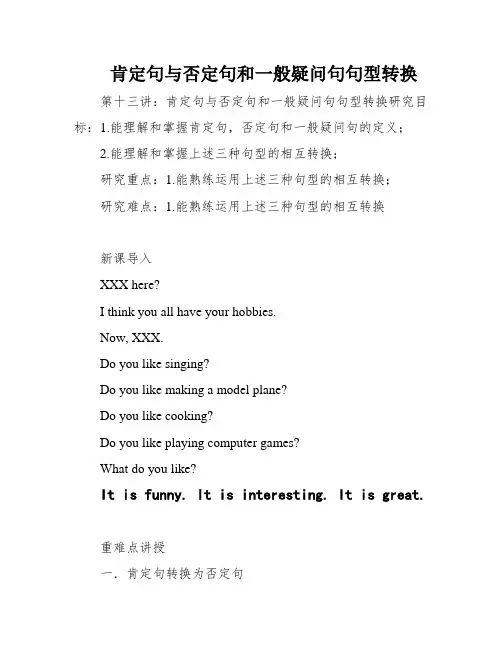
肯定句与否定句和一般疑问句句型转换第十三讲:肯定句与否定句和一般疑问句句型转换研究目标:1.能理解和掌握肯定句,否定句和一般疑问句的定义;2.能理解和掌握上述三种句型的相互转换;研究重点:1.能熟练运用上述三种句型的相互转换;研究难点:1.能熟练运用上述三种句型的相互转换新课导入XXX here?I think you all have your hobbies.Now, XXX.Do you like singing?Do you like making a model plane?Do you like cooking?Do you like playing computer games?What do you like?It is funny. It is interesting. It is great.重难点讲授一.肯定句转换为否定句1.含be动词(is/am/are)的否定(否定词is /am/are+not)(1) there be句型中的否认There is a cat in the tree._______________________________________There are some flowers in the garden.______________________________________XXX._______________________________________(2)人称代词She/ He/ It is a student._______________________________________ We/ They are your friends._______________________________________(3)指示代词This/ That is an English book._______________________________________XXX are very big and yellow. _______________________________________(4)名词,人名,地名,等名词性质类词。

一般疑问句的改法 Company number:【WTUT-WT88Y-W8BBGB-BWYTT-19998】一般疑问句的改法:对含有be(am、is、are等)动词、情态动词(can、may、must、should等)和助动词(will、would等)的句子,应直接将这些be动词、情态动词和助动词提到句首。
口诀“一调、二改、三问号”就说明了一般疑问句的变法:一调就是将be动词、情态动词和助动词提到句首,二改就是将大小写进行变化;将some改为 any; 将你(you)、我(I)进行变换,三问号就是在末尾加一个问号。
如果一个句子中没有be动词、情态动词或助动词,则需要助动词来帮忙。
如果主语是第三人称单数(he、she、it或者是单数名词等),就在句首加does,同时后面的谓语动词要恢复原形;如果是其他人称则在句首加do.如:Jim is I s Jim eighteenJim’s father can make a C an Jim’s father make a planeJim’s children like Do Jim’s children like dancingTom gets up late. --- D oes Tom get up late一般疑问句的答法:一般用Yes/No来回答,在Yes/No后面加上对应的人称代词的主格(I/you/he/she/it/we/you/they)和对应的be动词或情态动词或助动词(do/does)(一般就是一般疑问句的开头的那个be动词或情态动词或助动词)如:上面的四句肯定回答 Yes, he , they can.Yes, they do. Yes, he does.否定句的改法:对含有be(am、is、are等)动词、情态动词(can、may、must、should等)和助动词(will、would等)的句子,应直接在这些词的后面加上not即可。
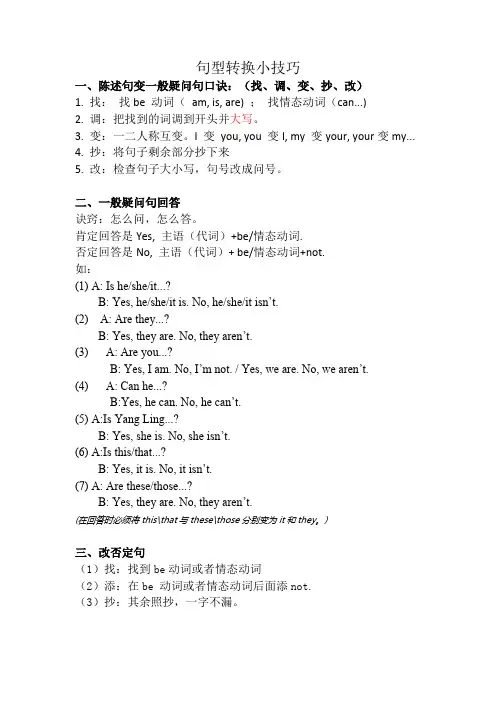
句型转换小技巧一、陈述句变一般疑问句口诀:(找、调、变、抄、改)1. 找:找be 动词(am, is, are) ;找情态动词(can...)2. 调:把找到的词调到开头并大写。
3. 变:一二人称互变。
I 变you, you 变I, my 变your, your变my...4. 抄:将句子剩余部分抄下来5. 改:检查句子大小写,句号改成问号。
二、一般疑问句回答诀窍:怎么问,怎么答。
肯定回答是Yes, 主语(代词)+be/情态动词.否定回答是No, 主语(代词)+ be/情态动词+not.如:(1) A: Is he/she/it...?B: Yes, he/she/it is. No, he/she/it isn’t.(2) A: Are they...?B: Yes, they are. No, they aren’t.(3) A: Are you...?B: Yes, I am. No, I’m not. / Yes, we are. No, we aren’t.(4) A: Can he...?B:Yes, he can. No, he can’t.(5) A:Is Yang Ling...?B: Yes, she is. No, she isn’t.(6) A:Is this/that...?B: Yes, it is. No, it isn’t.(7) A: Are these/those...?B: Yes, they are. No, they aren’t.(在回答时必须将this\that与these\those分别变为it和they。
)三、改否定句(1)找:找到be动词或者情态动词(2)添:在be 动词或者情态动词后面添not.(3)抄:其余照抄,一字不漏。
四:对划线部分提问(1)看划线部分是什么(2)确定特殊疑问词,写在开头(3)遮住划线部分,剩余部分改为一般疑问句(4)句号改为问号特殊疑问词:单词意思用法when什么时间问时间who谁问人where在哪里问地点what time什么时间问时间what colour什么颜色问颜色what about…怎么样问意见how…怎么样问情况how old多大问年龄how many多少问可数名词数量how much多少问价钱或不可数名词数量how about…怎么样问意见。
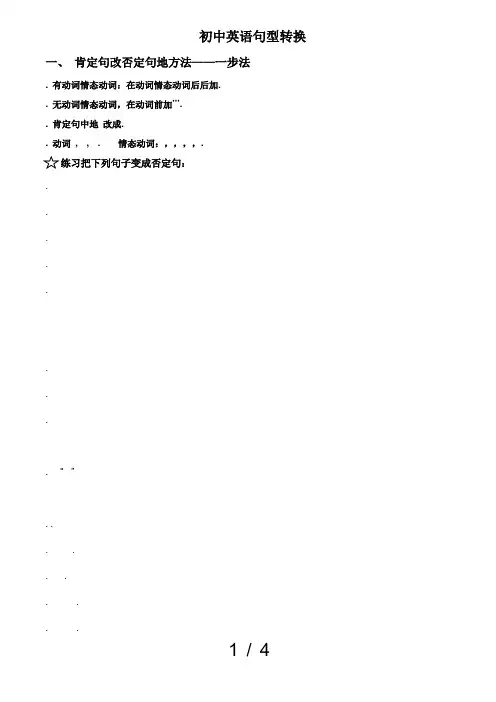
初中英语句型转换一、肯定句改否定句地方法——一步法. 有动词情态动词:在动词情态动词后后加.. 无动词情态动词,在动词前加’’’.. 肯定句中地改成.. 动词, , . 情态动词:,,,,.练习把下列句子变成否定句:......... “ ”. .. .. .. .. .二、肯定句改一般疑问句地方法——三步法. 有动词情态动词:动词情态动词提到句首,其余照抄,(改,改)句末用问号. . 无动词情态动词,在句首加,其余照抄,(改,改)句末用问号.. 加、地句子注意,句子动词要变成原型.例如:陈述句: . ..一般疑问句: ? ?陈述句: . .一般疑问句:? ?把下列句子变成一般疑问句......... “ ”. .三、肯定句改特殊疑问句地方法——四步法关于特殊疑问词问人(谁)地点(何地)时间(何时) 、 东西职业事物(什么) 方式方法程序身体(怎样) 原因 哪一个年龄 ..怎么样(提建议)多少钱谁地 (, …) 问星期 问日期问数量多少 (可数名词) (…) 问数量(不可数名词) (…) 颜色 班级 年级、在一般疑问句地基础上,句首添加一个疑问词即可,可根据划线部分确定是什么疑问词. 、接着找动词或,, 等放在疑问词后面,若没有则请助动词帮忙,写在疑问词后面, 除外,必须先写物品,再写动词等.b5E2R 。
、划线部分去掉后剩下地内容照抄,( 改成,改成等) 、句点改成问号.练一练、: ? ’ . 、: ? ’ . 、: ? ’ . 、: ? : ’ . 、: ? . 、: ? ’ . 、: ? ’ . 、: ? : . 、: ? ’ . ? : ’ . 、 ? : ’.综合练习:1. .否定句: 一般疑问句: 对划线部分提问:个人收集整理-ZQ 2. .(音乐会)否定句:一般疑问句:对划线部分提问:. .否定句:一般疑问句:肯定否定回答:. .否定句:一般疑问句:对划线部分提问:. .否定句:一般疑问句:肯定否定回答:对划线部分提问:. .否定句:一般疑问句:肯定否定回答:对划线部分提问:. .否定句:一般疑问句:肯定否定回答:对划线部分提问:. .否定句:一般疑问句:肯定否定回答:对划线部分提问:。

句型转换一般疑问句句型转换是英语学习中的一个重要环节,通过转换句型可以增强语言表达的灵活性和多样性。
在英语中,一般疑问句是常见的一种句型形式,下面将介绍句型转换一般疑问句的方法和注意事项。
一、方法1. 谓语动词+主语将句子中的谓语动词移到句首,主语移到谓语动词之后,变为一般疑问句形式。
陈述句:“He likes playing football.”转换为一般疑问句:“Does he like playing football?”2. 助动词+主语+动词原形在句子前面增加助动词do,主语移到助动词之后,动词变为原形,变为一般疑问句形式。
陈述句:“They have been to Beijing.”转换为一般疑问句:“Have they been to Beijing?”3. 疑问词+助动词+主语+谓语将疑问词放在句首,然后加上助动词do,主语移到助动词之后,谓语不变,变为一般疑问句形式。
陈述句:“She is a teacher.”转换为一般疑问句:“Is she a teacher?”二、注意事项1. 特殊疑问词的使用当句子中含有特殊疑问词(如what, when, where, why, how等)时,需要将特殊疑问词放在句首,然后按照上述方法进行句型转换。
陈述句:“Tom goes to school by bus.”转换为一般疑问句:“How does Tom go to school?”2. 助动词变化当句子中含有助动词或情态动词时,需要注意助动词或情态动词在疑问句中的变化。
陈述句:“They can speak English.”转换为一般疑问句:“Can they speak English?”3. 反意疑问句的构成在句型转换中,如果想要构成反意疑问句,只需要在句子末尾加上一个与句首主语和动词形式相对应的简单疑问句即可。
陈述句:“You are a student, aren't you?”通过以上方法和注意事项,我们可以轻松地将陈述句转换成一般疑问句。
七年级英语句型转换题英语句型转换是提高语言运用能力和理解能力的重要训练方法之一。
在七年级的英语学习中,句型转换可以帮助学生更好地掌握英语语法规则,提高句子的表达能力,增加对不同语言结构的理解。
下面将详细介绍一些七年级英语句型转换题。
一、陈述句与一般疑问句转换1. 陈述句:He is a student.一般疑问句:Is he a student?2. 陈述句:She plays tennis every Sunday.一般疑问句:Does she play tennis every Sunday?3. 陈述句:They have lunch at 12:00.一般疑问句:Do they have lunch at 12:00?4. 陈述句:We live in London.一般疑问句:Do we live in London?5. 陈述句:You like chocolate ice cream.一般疑问句:Do you like chocolate ice cream?二、一般疑问句与陈述句转换1. 一般疑问句:Can she swim?陈述句:She can swim.2. 一般疑问句:Have they been to Beijing?陈述句:They have been to Beijing.3. 一般疑问句:Is it raining?陈述句:It is raining.4. 一般疑问句:Did he watch TV last night?陈述句:He watched TV last night.5. 一般疑问句:Do you like pizza?陈述句:You like pizza.三、陈述句与否定句转换1. 陈述句:She is a doctor.否定句:She is not a doctor.2. 陈述句:I can swim.否定句:I cannot swim.3. 陈述句:We visit our grandparents every summer.否定句:We do not visit our grandparents every summer.4. 陈述句:He likes playing basketball.否定句:He does not like playing basketball.5. 陈述句:They have finished their homework.否定句:They have not finished their homework.四、特殊疑问句与陈述句转换1. 特殊疑问句:What is your name?陈述句:My name is Tom.2. 特殊疑问句:When did you wake up this morning?陈述句:I woke up this morning.3. 特殊疑问句:Where is the nearest supermarket?陈述句:The nearest supermarket is here.4. 特殊疑问句:How many students are there in your class?陈述句:There are 30 students in my class.5. 特殊疑问句:Why did you go to the park yesterday?陈述句:I went to the park yesterday for a picnic.通过以上的例题,可以看出七年级英语句型转换题主要包括陈述句与一般疑问句的转换、一般疑问句与陈述句的转换、陈述句与否定句的转换以及特殊疑问句与陈述句的转换等。
转一般疑问句
转一般疑问句是英语语法中的一种转换方式,用于将陈述句转换为疑问句。
在转换过程中,需要将陈述句中的助动词或be动词移至句首,并在句末加上问号。
下面将通过例句来解释如何转换一般疑问句。
1.陈述句:He is a teacher.
疑问句:Is he a teacher?
2.陈述句:They have finished their homework.
疑问句:Have they finished their homework?
3.陈述句:She can play the piano.
疑问句:Can she play the piano?
4.陈述句:We should go to the meeting.
疑问句:Should we go to the meeting?
5.陈述句:I am going to the store.
疑问句:Am I going to the store?
通过上述例句,可以看出转换一般疑问句的方法是将陈述句中的助动词或be动词移至句首,然后在句末加上问号。
需要注意的是,如果陈述句中没有助动词或be动词,那么需要根据上下文来确定应该使用什么助动词或be动词进行转换。
总结来说,转一般疑问句是英语语法中的一种转换方式,用于将陈述句转换为疑问句。
在转换过程中要注意将助动词或be动词移至句首,并在句末加上问号。
希望这篇文章对你有所帮助,如果有其他问题,请随时提问。
初中英语句型转换一、 肯定句改的方法——一步法1. 有 be 动词(is are am were was)/情态动词(can,could, will, would, shall, should,must,may)的。
在 be 动词/情态动词后后加 not。
2. 无 be 动词/情态动词,一般现在时在动词前加 don’t 第三人称单数前 doesn't/一般过去式 didn’t。
3 加 doesn't/ did n’t 的句子注意,句子动词要变成原型。
二、 肯定句改一般疑问句的方法——三步法1. 有 be 动词/情态动词:be 动词/情态动词提到句首,其余照抄,句末用问号。
2. 无 be 动词/情态动词,在句首加 Do/Does/Did,其余照抄,句末用问号。
注意(some 改成 any,第一人称变为第二人称 my 改成 your , I 改成 you,we 改成 you,our 改成 your )3. 加 Does、did 的句子注意,句子动词要变成原型。
例如 陈述句: They are in the park.He can play the guitar.He likes the dogs.否定句 They are not in the park. He can not play the guitar. He doesn't like the dogs一般疑问句: Are they in the park?Can he play the guitar?Does he like the dogs?特殊疑问词的用法who whom what whichwhose what color What time when where why howhow old意思 谁 谁什么 哪一个谁的 什么颜色用法 问人的身份,姓 名等 问人的身份,姓 名等(问宾语) 问人的职业或 事物是什么 问一定范围内 特指的人或物问所属关系问颜色(表语)例句He is LiLieWho is he ?He is my brother. Who is he ?I can ask him the question.Whom can you ask the question?He is a worker. What is he?He has a book. What does he have ?The big box is mine. Which box is yours?The girl at the door is Ann. Which girl isAnn?This is her book. Whose book is this ?This book is hers. Whose is this book?My skirt is red. What color is your skirt?几点 什么时候 什么地方 为什么 怎样多大几岁问点时间 问时间 问地点(状语) 问原因 问健康状况、 做事的方式等 问年龄We play games at five in the afternoon ? What time do you play games? We play games in the afternoon ? When do you play games? We play games at home on Sunday ? Where do you play games on Sunday? He isn't at school today because he is ill. Why isn't he at school today ? He is fine/strong. How is he ? I go home by bike. How do you go home? He is ten. How old is he ?how多少跟复数名词, There are thirty boys in my class.many问数量How many boys are there in your class?how多少跟不可数名词 There is some milk in the bottle.much问数量或价钱 How much milk is there in the bottle?how far 多远问路程It's five kilometers away from here?How far is it from here?how soon 多久问 in+一段时间 He can finish it in half an hour.How soon can he finish it ?how long 多久问一段时间, He has lived here for a year.问物体的长短 How long has he lived here?The desk is one meters long.How long is the desk ?how often 多久问频率I go to see my parents once a month.(一次)How often do you go to see your parents?How 的疑问句辨析一、how many 和 how much 的区别how many 用来询问可数名词的数量,它的句式是:How many+复数名词+一般疑问句+? how much 用来询问不可数名词的数量,也可询问价格。
初一英语句型转换陈述句变一般疑问句和否定句1 I can help you. 2 Tom’s T-shirt is five dollars. 3 I often watch TV on Sunday. 一、陈述句变一般疑问句的方法:1.对于助动词、情态动词、be动词作谓语的,动词作谓语的,把把be动词,can,shall, will, may等放在句。
如:首,(some 改成any,my改成your等),句点改成问号。
如:He's a teacher. →Is he a teacher? He c an swim. →Can he swim? He'd like to go there. →Would he like to go there? 2、含有have的一般疑问句,have译为“有”。
一般疑问句式有两种形式: 1.把have/has调到句首。
例如: 陈述句:Tommy has a computer. 一般疑问句:Has Tommy/he a computer? 2.加助动词do/does,第三人称单数用does,其他人称用do,过去式用did。
其句型例如上句可变为: 主语 + have...?例如上句可变为为:Do/Does + 主语Does Tommy have a computer? 3.对于实意动词作谓语的,动词原型借助do,三人称单数借助does,过去式借助did,加在句首,再把谓语改为动词原形,(some 改成any,my改成your等),句点改成问号。
其句型为:Do/Does/did + 主语 + 动词原形+其它如:如:I like him. →Do you like him? He likes me. →Does he like me? I liked him. →Did I like him? 注意:在把肯定句改成否定句或一般疑问句的时候,要注意句中是否有already、some、something、somebody等词,如果有也必须进行改变,already要改成yet,some、something、somebody等分别改成any、anything、anybody等。
一般疑问句的改法
一般疑问句是疑问句的一种,它是指用yes或no来回答的疑问句,其改法可以参考以下规则:
- 谓语动词是be动词、助动词、情态动词时,直接将其置于句首。
- 动词是行为动词时,在句首加上助动词Do、Does、Did后,动词改用原形。
下面列举一些例子进行说明:
- 第一家族:含be动词或情态动词的句子。
- 秘诀:一调二改三问号。
- 一调:即把句中的be或情态动词调到主语前。
- 二改:改换主语称谓,即将句中的主语I\my\mine\we\our\ours等第一人称分别改为相应的第二人称you\your\yours等。
- 三问号:句末的句号改为问号。
例如:I am an English teacher. → Are you an English teacher?
We can speak English fluently. → Can you speak English fluently?
- 第二家族:含行为动词(或称为实义动词)的句子。
- 秘诀:一加二改三问号。
- 一加:即在句首加助动词Do或Does。
- 二改:1. 把谓语动词改为原形;2. 改换主语称谓(同第一家族)。
- 三问号:句末的句号改为问号。
例如:I like playing basketball. → Do you like playing basketball?。
七年级英语上RJ一般疑问句(一般现在时)般疑问句是疑问句的一种。
它是只用yes(是)或no(否)来回答的句子。
其结构是:系动词be/助动词/情态动词+主语+其他成分通常回答为:肯定:Yes,+主语+提问的助动词.否定:No,+主语+提问的助动词的否定形式.1.将陈述句变为一般疑问句时,如句中有be 动词(am is are …)时,可直接将它们提至主语前。
I'minClass2Grade 1. → Are youin Class 2Grade 1?ﻫWe're watching TV. → Are you watching TV?2.陈述句中有情态动词(canmay must …)时,直接将它们提至主语前。
Hecan swim now.→ Canhe swim now?The childrenmaycomewith us. →May thechildren come withus?3.陈述句中有实义动词作谓语时,则由do或does(第三人称单数)引导,放在句首,且后面动词需变为原形。
I like these animals.→ Do you likethese animals?She wants togo tothemovies.→ Does she wanttogo tothe movies?ﻫ需要直接变化的词语I /me变成you we/us变成you my变成your our变成your am变成are some变成anyand变成orthis变成that these变成those陈述句的否定形式(一般现在时)1.含有系动词的句子在变否定句时只须“在系动词的后边加上not”,前面的几个了陈述句变否定句分别为I’m a Chinese boy. → I’m not a Chineseboy.She is twelve.→ She isn’t twelve.2.含有情态动词的句子(can ), 在变否定句时直接在情态动词的后边加上not She canplay basketball.→She can notplay basketball.Hismother’scousincan sing manyEnglishsongs.→His mother’scousin can not sing many English songs.3.错误!含有行为动词的句子在变否定句时只须在行为动词前加don’t .We don’thave many friends.→Wedon’t havemany friends.Thestudents don’t take their booksto school. →Thestudentsdon’ttake their books to school.错误!含有行为动词的句子,当主语是第三人称单数时,变否定句时“在行为动词前面加doesn’t, 且后面动词需变为原形”。